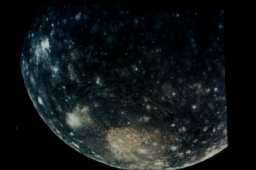This is an image of the Prometheus geyser.
Click on image for full size
NASA
Geysers of Io
When Voyager flew by Io the surprise discovery was the geyser, Prometheus, in full eruption. Geysers such as Prometheus spout pools of liquid around the vent, rather than a channel of lava.
Well known geysers of Io include:
You might also be interested in:

Amalthea was discovered by E Barnard in 1872. Of the 17 moons it is the 3rd closest to Jupiter. Amalthea is about the size of a county or small state. Amalthea is named after the goat in Greek mythology
...more
Callisto was first discovered by Galileo in 1610. It is the 2nd largest moon in the solar system, and is larger than the Earth's moon. It is about as big as the distance across the United States. Callisto
...more
Measurements by the Galileo spacecraft have been shown that Callisto is the same inside from the center to the surface. This means that Callisto does not have a core at the center. This means that, unlike
...more
Many different types of surface are shown in this picture. In the front is a huge crater, which goes for a long way over the surface. This crater could be compared to that of Mimas. They both show that
...more
The surface of Callisto is deeply marked with craters. Craters are the little white marks in the picture. It looks like it might be the most heavily cratered body in the whole solar system. And some of
...more
Europa was first discovered by Galileo in 1610, making it one of the Galilean Satellites. It is Jupiter's 4th largest moon, 670,900 km ( miles) from Jupiter. Europa's diameter is about half the distance
...more
The Galileo mission discovered an amazing thing! Europa has its own atmosphere, although it is very, very thin. When fast moving molecules traveling through space near Jupiter hit Europa's atmosphere,
...more














